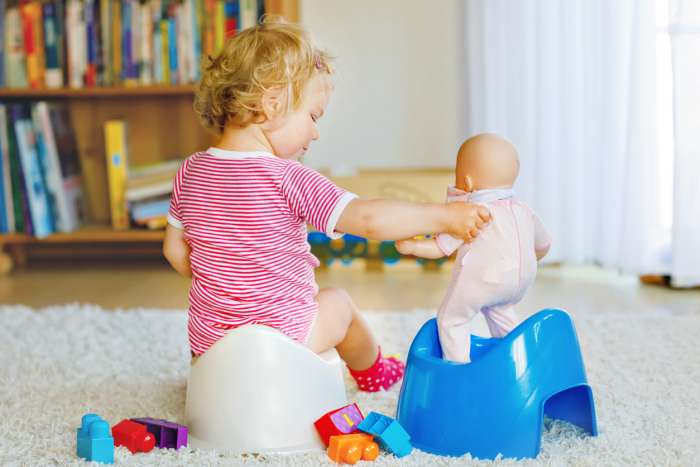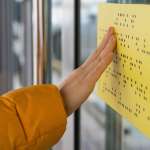If you are unsure about whether or not your toddler is ready to start potty training or toilet training, there are common emotional and physical signs you can look out for that indicate your child has reached the necessary child development milestones to transition to the potty.
It’s important that you let your child’s caregiver or daycare provider know that you are thinking about potty training. Different potty training tips will work for different toddlers, and some children feel nervous about using a toilet outside of their home when they are new to the process.
What Do Experts Say?
Before we dive into the common signs of potty training readiness, let’s take a look at what some of the top experts in the parenting field have to say on this topic.
Dr. Fran Walfish, relationship psychotherapist and author of The Self-Aware Parent, advises that, “The most important must-have a parent should invest in and commit to is the right attitude. It costs nothing and makes all the difference in the world to your child. The right attitude is to adopt the belief that your child is the boss of his(/her) own body. You are there to guide and praise every increment toward his independence, but you will not press or force.”
Potty training can be stressful for both parents and toddlers, but it can also be a positive and rewarding experience and an opportunity for parents to bond with their children.
Heather Wallace, facilitator of the Love and Logic Early Childhood Parenting Made Fun curriculum, explains that, “A toddler’s interest level is a key indicator of readiness. One thing you cannot control is your toddler’s bathroom habits. Therefore, making sure your toddler is ready to take control of this part of (their) development is imperative to success. Potty training is extremely stressful for the parent, so remember your breathing exercises when you find yourself frustrated with your toddler’s lack of mastery of this important developmental milestone.”
Teach Your Little One How to Read Braille With 7 Easy Steps
Children with visual impairments rely on their other senses like smell, touch, and taste to learn about the world around them. In the past, children with visual impairments had no way of reading or writing. Today, thanks to Louis Braille, many blind children can use braille to read and write. Read More
Common Signs of Potty Training Readiness

Your child’s readiness may depend on multiple factors. Deciding when your child is ready for this transition is not an exact science – there is no singular right age, but most children show signs of readiness by 18 to 24 months. There are are six common signs of potty training readiness that you can look out for in your little one:
1. They Have an Awareness of Body Sensations
Once children have developed a sense of awareness around their body sensations they will be able to tell when they need to go to the bathroom. Encouraging your child to listen to their body can be helpful when potty training. At the beginning, children may be so engaged in play that they won’t stop for the potty.
Pro parenting tip: Be prepared for accidents and possible frequent clean ups and use these incidents as opportunities for learning and language development.
2. They Stay Dry for Longer Periods
Once your child is able to keep a dry diaper for 2+ hours or longer, he or she may be ready to wean off the nappies. The ability to keep a diaper dry for extended periods of time is a good indicator that your child’s body is maturing and they are developing good bowel and bladder control.
Pro parenting tip: Start to take note of when your child is drinking so that you can plan potty trips accordingly. A trip at least every two hours is a good starting point that will allow for more potty training success.
3. They Are Curious and Interested
One indication that your toddler is ready to start potty or toilet training is that they have gained an interest in the potty. Perhaps they follow you to the bathroom, or they start to ask to use the toilet or potty.
Parenting Expert Elisa Cinelli says not to “get caught up on readiness signs other than curiosity and interest. I recommend starting toilet learning early, letting your child see you use the toilet, letting them sit and have their own toileting station that they can get to on their own. I like to set up a toileting station with potty and extra pull ups or training pants around the time they begin to walk.”
Pro parenting tip: You may be self conscious about having the company of your child in the bathroom, but children learn by observation. Allowing them to see you using the toilet will spark a level of curiosity and interest which will lead to a desire to try on their own.
Once the ball starts rolling, you can keep your child interested by creating a routine, providing an appropriate-sized potty seat, and even let them help pick out their own underpants as an incentive.
4. They Are Not Afraid of the Potty
There can be many fears that children have around using the potty or toilet – it is a big transition that takes time to get used to. Some common fears that children have include
- Falling
- The loud noise associated with flushing
- The act of having to flush away a poop. While it might seem silly, many children (boys in particular) can be scared or sad about having to flush their poop.
Pro parenting tips:
There are different ways you can combat these fears. For example, starting children with a toddler toilet seat or stand alone potty chair are ways to eliminate the fear of falling in. Additionally, as you begin the potty training process, you could allow your child to help you flush so that they feel a sense of control and anticipation of the loud sound.
For boys, try asking them to sit down when they pee at the start of the process. If a child is sitting for peeing, pooping often just happens naturally. If your child has regular bowel movements, plan bathroom trips around those times for more success.
If you notice that your child does develop a fear of pooping on the potty, forcing it can cause constipation or irrational fears. Let them poop in their diaper, but encourage them to still be in the bathroom.
5. They Have the Necessary Physical Motor Skills
Ideally a child should be able to pull up and down their pants, and get onto and off of a potty when they start potty training. If your child is getting themselves dressed in the morning and undressed at night, this is a sign that they have the necessary motor skills to start potty training.
Pro parenting tip: You can use a stool at the toilet for additional support to help your child feel independent. Toddlers may still need help dressing themselves, but encourage them to work at pulling up/down their pants and underwear, pull-ups, or diapers as part of the toileting process.
6. They Can Follow Simple Instructions
While you’re there for support, your child should be able to follow simple directions, such as
- Pulling clothes down then climbing onto the toilet
- Sitting for a few minutes to make sure they’re finished before wiping
- Pulling up pants and then flushing
- Always washing hands at the end
While you can support your toddler with many of these steps, cognitively they should be aware of the simple instructions they need to follow while working through the whole process. This can often become a power struggle, but potty training is more than just the act of going to the toilet, so your training method should encompass everything from beginning to end so that your child can fully master this new skill.



